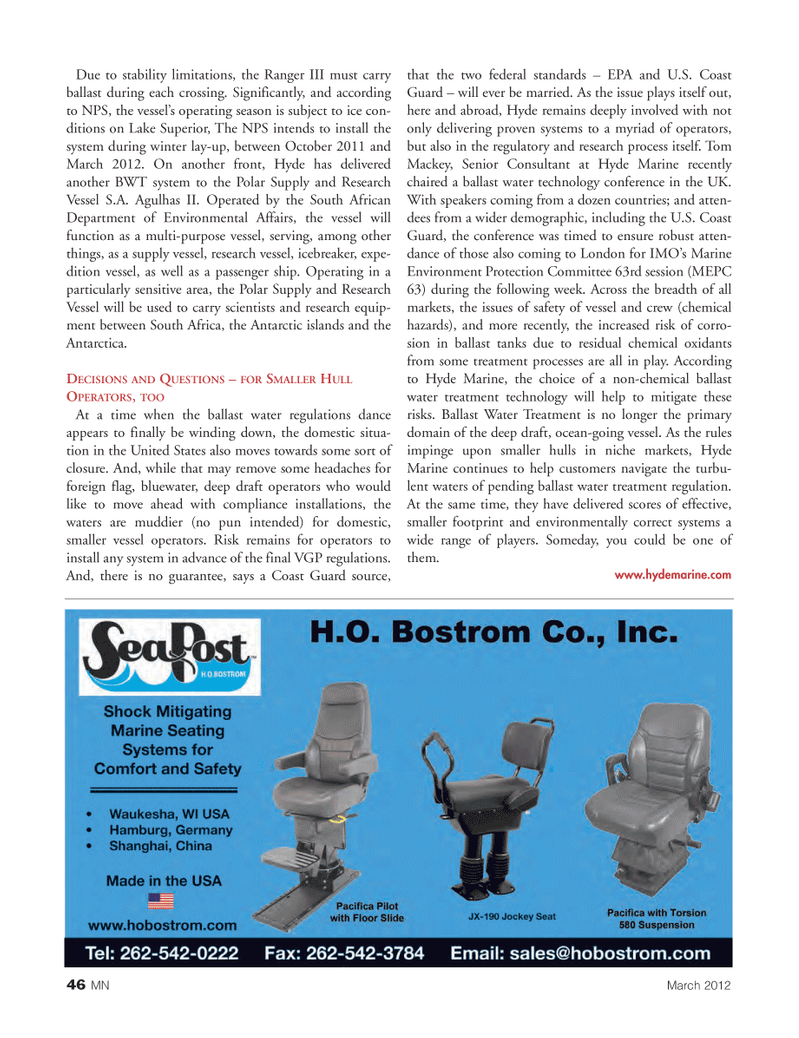
Page 46: of Marine News Magazine (March 2012)
Training & Education
Read this page in Pdf, Flash or Html5 edition of March 2012 Marine News Magazine
Due to stability limitations, the Ranger III must carry ballast during each crossing. Significantly, and according to NPS, the vessel?s operating season is subject to ice con- ditions on Lake Superior, The NPS intends to install the system during winter lay-up, between October 2011 and March 2012. On another front, Hyde has delivered another BWT system to the Polar Supply and Research Vessel S.A. Agulhas II. Operated by the South African Department of Environmental Affairs, the vessel will function as a multi-purpose vessel, serving, among other things, as a supply vessel, research vessel, icebreaker, expe- dition vessel, as well as a passenger ship. Operating in a particularly sensitive area, the Polar Supply and Research Vessel will be used to carry scientists and research equip- ment between South Africa, the Antarctic islands and the Antarctica. DECISIONSAND QUESTIONS? FORSMALLERHULLOPERATORS , TOO At a time when the ballast water regulations dance appears to finally be winding down, the domestic situa- tion in the United States also moves towards some sort of closure. And, while that may remove some headaches for foreign flag, bluewater, deep draft operators who would like to move ahead with compliance installations, the waters are muddier (no pun intended) for domestic, smaller vessel operators. Risk remains for operators to install any system in advance of the final VGP regulations. And, there is no guarantee, says a Coast Guard source, that the two federal standards ? EPA and U.S. Coast Guard ? will ever be married. As the issue plays itself out, here and abroad, Hyde remains deeply involved with not only delivering proven systems to a myriad of operators, but also in the regulatory and research process itself. Tom Mackey, Senior Consultant at Hyde Marine recently chaired a ballast water technology conference in the UK. With speakers coming from a dozen countries; and atten- dees from a wider demographic, including the U.S. Coast Guard, the conference was timed to ensure robust atten- dance of those also coming to London for IMO?s Marine Environment Protection Committee 63rd session (MEPC 63) during the following week. Across the breadth of all markets, the issues of safety of vessel and crew (chemical hazards), and more recently, the increased risk of corro- sion in ballast tanks due to residual chemical oxidants from some treatment processes are all in play. According to Hyde Marine, the choice of a non-chemical ballast water treatment technology will help to mitigate these risks. Ballast Water Treatment is no longer the primary domain of the deep draft, ocean-going vessel. As the rules impinge upon smaller hulls in niche markets, Hyde Marine continues to help customers navigate the turbu- lent waters of pending ballast water treatment regulation. At the same time, they have delivered scores of effective, smaller footprint and environmentally correct systems a wide range of players. Someday, you could be one of them. www.hydemarine.com 46MNMarch 2012 MN#3 (32-49):MN 2011 Layouts 3/2/2012 10:37 AM Page 46

 45
45

 47
47
